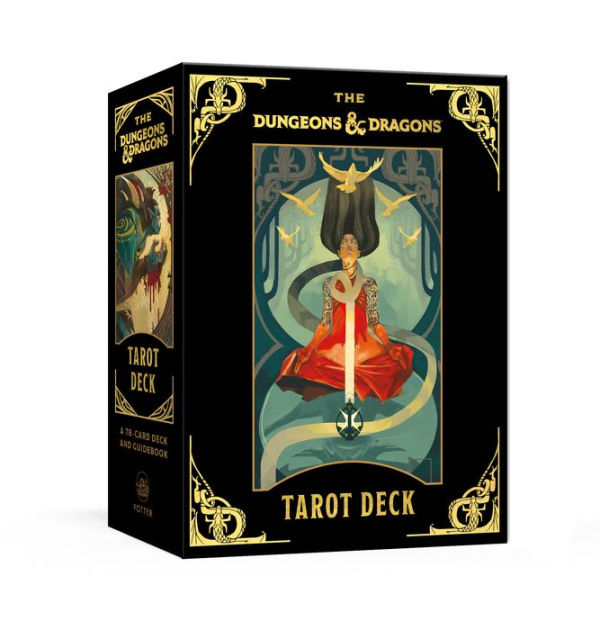
Author
Bob Andug
Artist
Van Gaugin
Publisher
Magic Cards, Ltd.
Deck Type
Tarot – 78 Cards – Minor Arcana Images – Non Standard Suits
I confess to having been one of those nerds in the 1980s that was heavily into Dungeons and Dragons. I had all the core books, several of the supplements, and boxes of strange little people and things that I trundled off to whichever of my fellow nerd’s homes we were playing at that weekend.
After college and life moving on, mortgages and kids, and all those things that happen (even to D&D nerds) in adulthood, the books remained unopened and the dice gathered dust. The game system evolved over the intervening years and now resembles only slightly that of my first edition tomes. Yet I still have enough of an interest to crack the new volumes open at the mass market bookseller and see what is going on.
So it should be no surprise that when I saw an officially sanctioned Dungeons and Dragons Tarot that I picked it up off the shelf at the Thorn and Moon Apothecary. Expecting a mass market gloss, and at worst bad fantasy kitsch, I was quite surprised how drawn I was to the artwork. After a brief look through of the card images online, I added the deck to my basket and brought it home.
Artwork is why I buy Tarot. I have been reading for a half century, so I am well acquainted with the meanings of the cards, and don’t usually look for additional commentary in the included booklets. In this case, however, once one is past the Major Arcana and it’s more or less conventional cards, reference to the book is probably going to be a requirement for most readers.
The suits of this deck have chosen to employ some of the core attributes of the character system from the game. Without going too deep for non-players, in D&D, one rolls the dice to get a number value for certain traits in a character, that they then must work with in the role-play adventure. The Tarot use the traits Strength, Intelligence, Wisdom, and Charisma for the suits.
If you have played D&D, you can probably warm up to how this works without too much effort, and then apply the usual Tarot interpretations of the card values, much like you would do with a pip-based deck. But if you are looking for some linking to the standard Wands, Cups, Swords, and Pentacles, or even their elemental associations, you won’t find much.
Don’t get me wrong. The artwork is excellent, and there is much to explore and interpret, but you will find wands and swords and cups and stones and fire and air and water and earth in each suit, sometimes on the same card. This can tend to leave a practiced reader dangling, as we have a habit of looking for those clues.
There are a couple of options in this case. One can go to the little book, and grab the two or three line interpretation (nothing for reverses) or meditate on the prose narrative assigned to each card. Alternatively, and I believe this will be my approach, one can simply use the artwork as a jumping off point, and seek their own meanings from there. Ultimately Tarot is an intuitive practice. If the cards are not in step with the meanings of the standard RWS decks, then one needn’t confine themselves to learning a new set of “rules” just so they can integrate the reading into the D&D universe.
If you’re still an active player, perhaps the assigned meanings will be of more value to you. In my case, it’s only of moderate interest.
I give the deck four stars for the artwork, and for being bold enough to put out a fully rendered Minor Arcana with alternative suits and new meanings. I detract that final star because the supporting book falls short of the potential of that ambition.
Larry S. Evans II is an artist, filmmaker, and blogger on Esoterica, the Occult, and Tarot. He lives with his wife of 30+ years and his cats in the suburbs of Houston, Texas.

